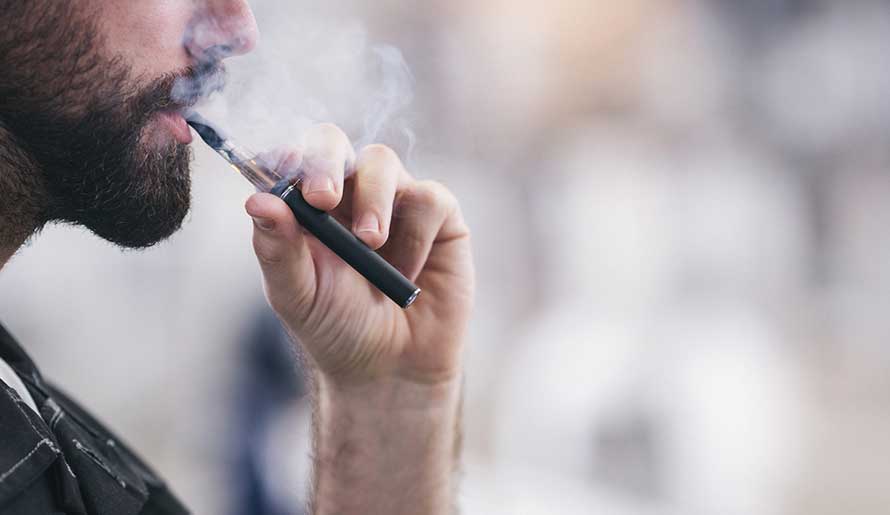Lung Cancer and Vaping

Like most people, you probably know that smoking has been proven to cause lung cancer. So, if you are inclined to kick the habit, you might consider vaping as a first step. But is it safe?
E-cigarettes work similarly to a nebulizer, which is a device used to convert medication to mist form so it can be delivered deep into the lungs. Both use heat to transform a liquid into aerosol form, which is then inhaled. Although inhaling a vapor might sound harmless, it is far from it.
The dangers of nicotine
Most e-liquids contain nicotine, the same toxic and highly addictive stimulant contained in traditional cigarettes. Nicotine makes you crave a smoke; if you ignore the craving, you may experience withdrawal symptoms, such as irritability, restlessness, hunger, difficulty concentrating, sleep disruption and depression. Nicotine also raises your blood pressure and spikes your adrenaline, both of which increase your heart rate and risk of a heart attack. The bottom line is that instead of discontinuing your addiction, vaping can create the opposite effect by increasing the amount of nicotine you consume.
Other harmful chemicals in vapor
While nicotine is dangerous, it is not known to cause lung cancer. However, nicotine is not the only harmful substance contained in e-cigarette vapor. At a minimum, e-liquids contain flavors, sweeteners and solvents. All ingredients are “generally recognized as safe” by the Food and Drug Administration—but only when consumed as food. When heated and transformed into aerosol form, these “safe” ingredients can take on vastly different properties, and little is known about the effects of inhaling them.
Scientists do know that vaping coats the lungs with a toxic cocktail that may contain:
- Carcinogenic chemicals – Some of the volatile organic compounds (VOCs) commonly found in vapor, such as benzene and heavy metals, are known to cause lung cancer and pose other health risks.
- Diacetyl – A food additive, this butter-flavored liquid is generally safe to ingest. However, when inhaled directly into the lungs, it can cause scarring in the air sacs, which in turn can cause the airways to thicken and narrow (“popcorn lung”).
- Ultrafine particles – When inhaled deep into the lungs, tiny particles can become lodged in the trachea and bronchi and worsen respiratory conditions, such as asthma. They can also constrict the arteries in the lungs, potentially triggering a heart attack. Although tobacco smoke also contains particles, vapor contains them in much higher concentrations.
Although the long-term health effects of e-cigarettes are not yet well understood, research studies performed to date clearly indicate vaping is not a safe or healthy alternative to smoking. Furthermore, vaping can increase the risk of lung cancer.
Get the help you need to quit once and for all
At Moffitt Cancer Center, we relate to urgency. If you are ready to quit smoking, you can receive personalized support from a certified tobacco treatment specialist in our Tobacco Treatment program. To learn more or request an appointment, contact us by phone at 1-813-745-8811 or via email at TobaccoTreatment@moffitt.org. In the meantime, we invite you to review our frequently asked questions about lung cancer and explore our comprehensive lung cancer screening and surveillance program for current and former smokers.
References
American Lung Association – What’s in an E-Cigarette?
The U.S. Department of Health and Human Services – Know the Risks – E-Cigarettes and Young People
Centers for Disease Control and Prevention – About Electronic Cigarettes
The American Heart Association – Is Vaping Better Than Smoking?
FAQs
- Signs and Symptoms
- Diagnosis
- Treatment
- FAQs
- Lung Cancer Early Detection Center
- Lung Cancer Screening and Surveillance Program
- Lung Nodules
- Lung Surveillance Clinic
- Metastatic Lung Cancer
- Recurrence
- Survival Rate
- Your Lung Cancer Specialists
- Lung and Thoracic Tumor Education (LATTE)
- Thoracic Clinic Updates
- Insurance & Financial Information
